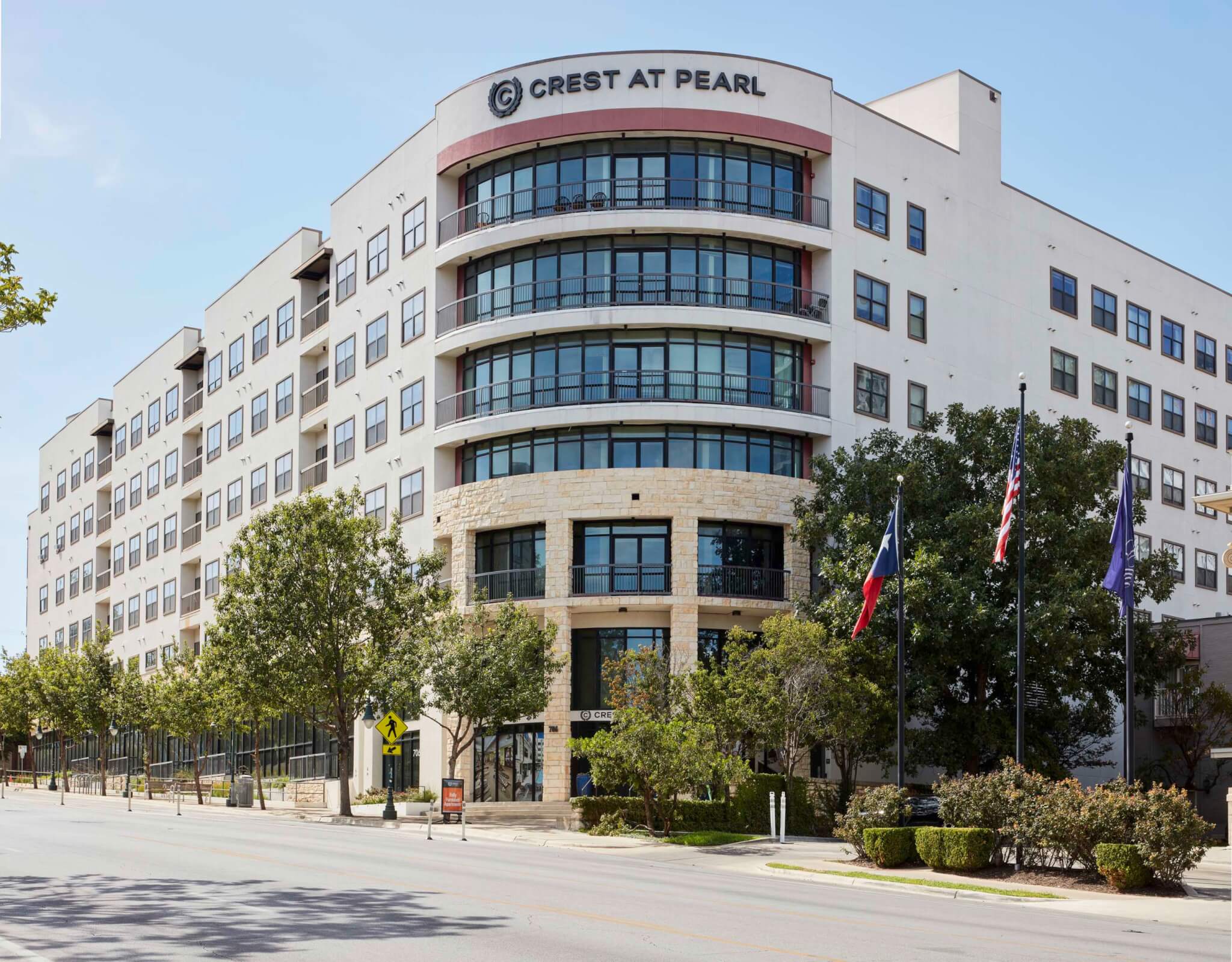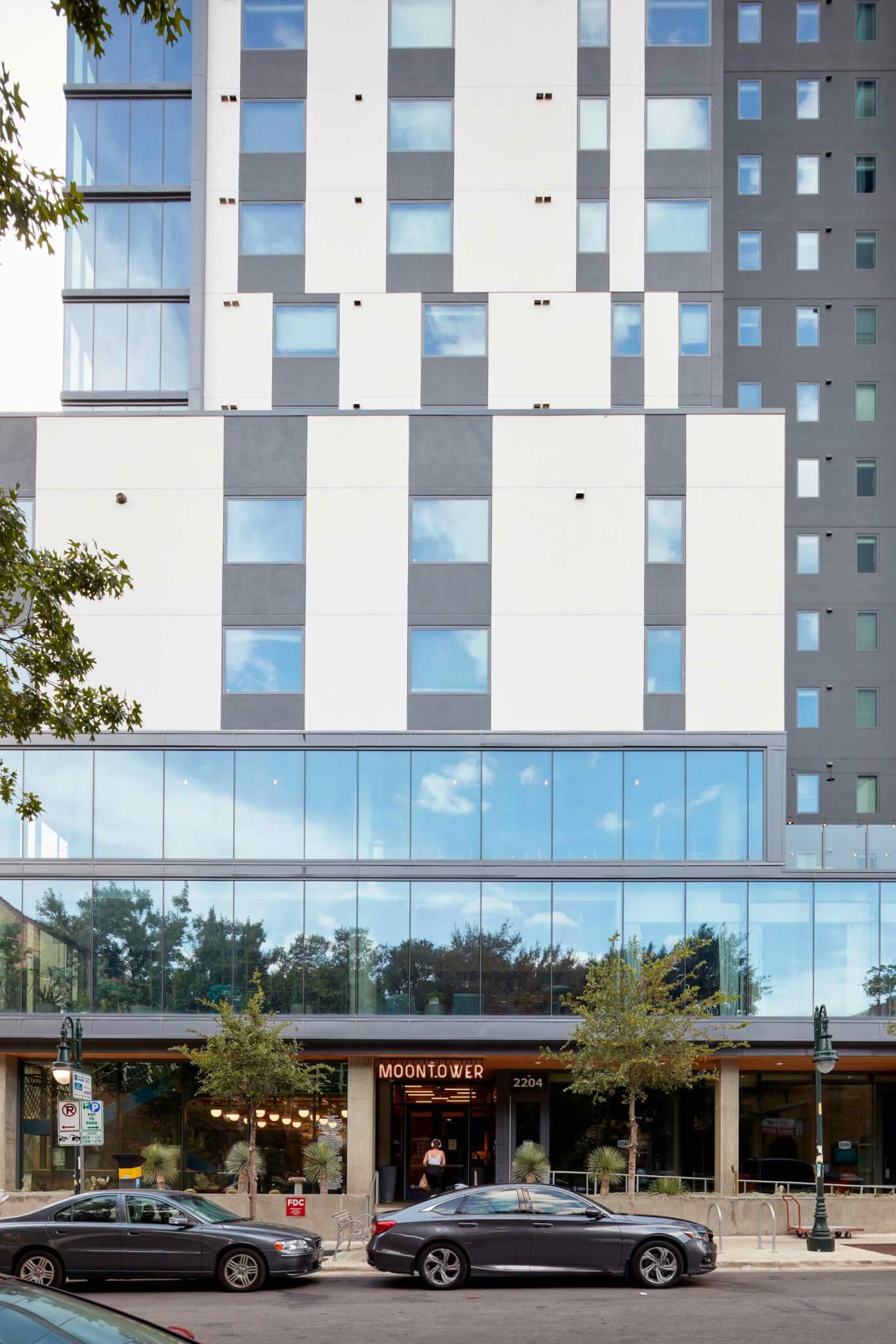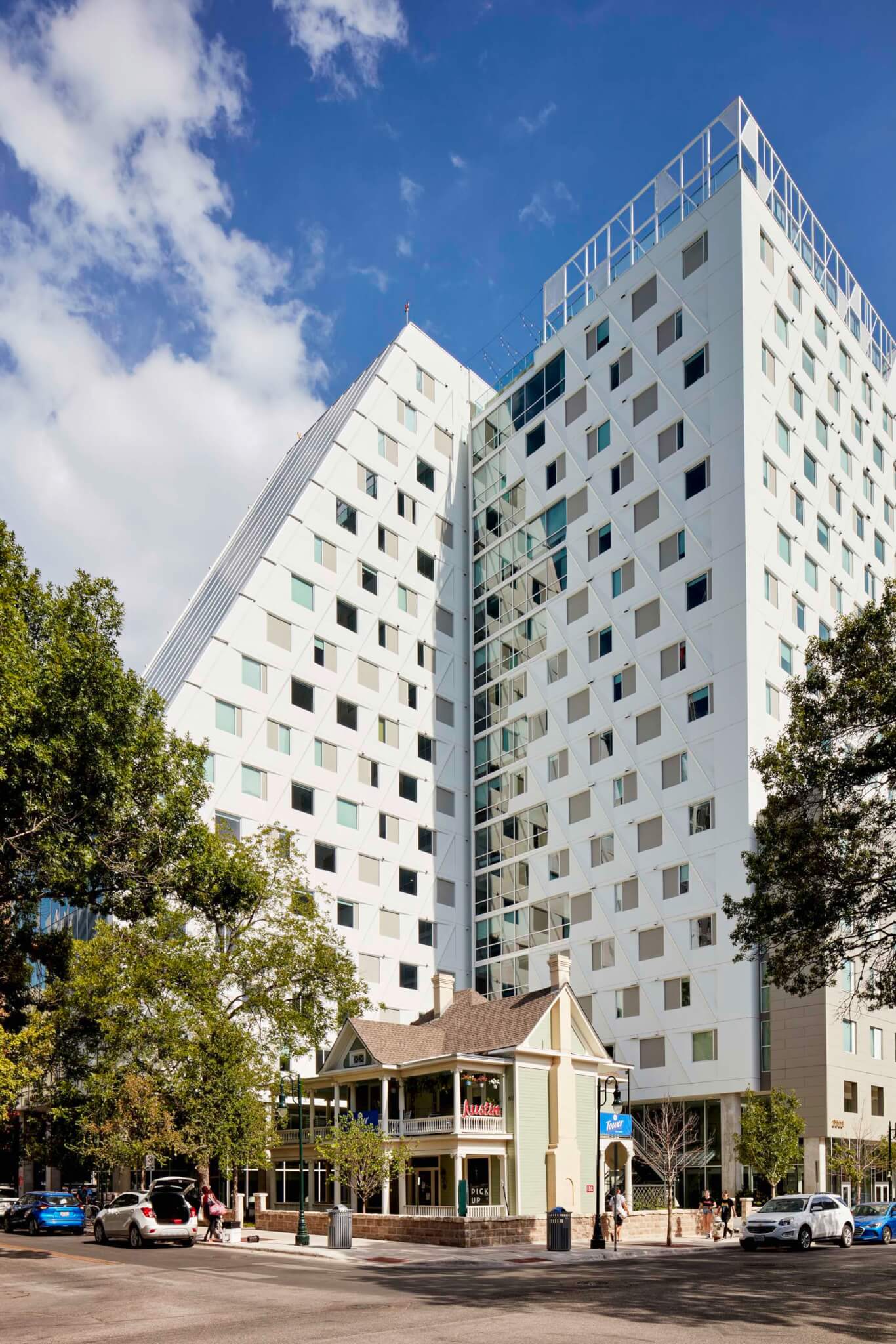“Did you know that many UT students are renting windowless rooms in the brand-new buildings in West Campus?” I have asked many architects in Austin this question. Most of them answer with a mix of surprise and incredulity: “You can’t do that; it’s illegal”—just as I did when I learned of this issue myself last fall.
Unfortunately, we were all wrong. It is perfectly legal.
The depressing reality is that the city of Austin has been issuing building permits for several years to construct windowless rooms in West Campus. For example, 44 percent (222 rooms) of the bedrooms in the Ion Austin building have no windows. Likewise, the Legacy on Rio building has 115 bedrooms, or 22 percent, without windows. Many other new buildings share similar statistics, and presumably more are in the development pipeline across the city.

This is alarming; windowless rooms have detrimental effects on building occupants, and our acquiescence with their design puts our profession in a terrible light. It must stop.
The benefits of natural light on people’s general well-being—not to mention its preventive effects on such mental health conditions as depression, anxiety, sleep disorders, and stress—are well documented. Students may not be fully aware of the health ramifications when they sign leases for apartments with windowless rooms, but many have shared their “dreadful experiences” after the fact.
Most speak about trying to avoid spending time in their room, but there is no escape. One student reports: “From the moment you wake up, it is a very confusing and anxious experience.” “Waking up every morning in total darkness never fails to create anxiety, which is a terrible start to each day,” commented another. This is, of course, in line with research findings on the negative health impacts associated with circadian rhythm disruptions.
Another student’s experience corroborates research linking depression and the absence of natural light: “While being in my windowless room, I have experienced symptoms of depression and fatigue quite often. It is very hard to get motivated, almost to the point where you feel trapped.”
American colleges are experiencing a well-documented mental health crisis—illustrated by rising suicide rates among students—so it is particularly distressing to hear students say: “The loneliness and claustrophobia caused by the four solid walls is unbearable,” or “Your room is the place [that] you should feel the most comfortable in. It’s meant to be your safe haven, not your prison.”
The mental health crisis has been exacerbated by ongoing confinement and social isolation during the COVID-19 pandemic (which most likely will not be the last one)—a particularly bad time to be depriving students of natural light.

One student, who lived in a “ground floor, three-bedroom, three-bathroom apartment that has no windows in any of the bedrooms,” puts the blame squarely on our profession: “The darkness and reliance on artificial light is not only a sad reality of poor architecture but is also depressing and anxiety inducing.”
Poor architecture is indeed part of the problem. According to the AIA website, a guiding principle of our profession is to “design a healthier built environment.” The site further states that, for architects, “it is critical to consider the physical, mental, and emotional effects a building has on its occupants and the surrounding community.” The West Campus rooms certainly don’t meet this standard, nor does the monstrous Munger Hall on the UC Santa Barbara campus, an 11-story dormitory that received national media attention last year when it was revealed that 94 percent of its units lack windows.
In addition, the total reliance on forced ventilation and artificial lighting to make bedrooms “habitable” goes directly against the sustainability aspirations professed by both the AIA and the city of Austin.
In January, I wrote an article published in ArchDaily (“The Dark Side of Density. The Tragic Emergence of Windowless Rooms in the U.S.”), calling for a national ban on windowless rooms. Fifteen thousand people read it; students and parents wrote in support. I then contacted AIA national leadership to determine their position on this issue and find out how architecture professionals can work together to remedy the situation. I also asked for their help identifying cities in the U.S. that have habitability standards in place at the state or municipal level. I found no encouragement and no acknowledgement of the problem. They just redirected me to a Codes and Standards Committee official who offered little help.
I decided to refocus at the local level. A colleague from UT Austin, professor of history Alberto Martinez, joined me in the cause, and we wrote an Op-Ed for the Austin American Statesman in April (“Windowless Rooms for Students: It Should be Illegal”), urging the Austin City Council to ban windowless rooms. No response. We then sent a group letter—with 44 colleagues from the School of Architecture and the Departments of Psychiatry and Behavioral Sciences, Psychology, and Neurology joining us—to each Austin City Council member, again urging them to act. One council member responded, concerned about the situation, but there was no word from the mayor nor from the other nine council members.
This essay is an effort to rally support from architects. For many of us, it is mind-boggling that we are even having this debate in Austin today. It is a non-issue in most large cities where windowless rooms were banned, in some cases, more than 100 years ago.

It is this simple: If windowless rooms were to be made illegal, developers would not request them, and architects would not be asked to design them—as has been the case with the adoption of ADA requirements. This has already happened in cities as diverse as New York, Los Angeles, Madrid, and Mexico City. These cities have established habitability standards that outline minimum expectations for humane habitation, independent of safety issues such as fire egress and guardrails. Lawmakers in these cities have made it very clear that windowless rooms—like the ones being built in Austin—are illegal. The issue is not open to interpretation; it is clearly regulated, independently of national or international building codes.
Each city’s regulation includes language describing what is considered a habitable room, which in all cases includes living rooms and bedrooms. It then clearly spells out the minimum requirements for natural light and natural ventilation for each habitable room. These are measured as a percentage of the floor area of the room in question. In New York City, rooms must have windows measuring a minimum of 10 percent of the floor area of the room, with 5 percent being operable for ventilation. These percentages vary from city to city: in Madrid, it is 12 percent for natural light and 8 percent for ventilation; in Mexico City, 15 percent and 5 percent, respectively.
In California, the issue is regulated at the state level by the California Building Code, and the percentages required are 8 percent for natural light and 4 percent for ventilation. Strangely, the University of California, the premier public university in the most progressive state in the country, is allowed to ignore its own state code, offering no natural light or ventilation in the rooms of the 4,230 residents of Munger Hall.
Similarly, how does Austin—one of the most progressive cities in the U.S.—find itself in this regressive situation? Why do we need to be making the case for something with such common-sense benefits as those of windows?
In 2004, the city approved the zoning change that made the transformation of the West Campus neighborhood possible. The goals were to “promote high-density redevelopment” by replacing mostly one- and two-story buildings with towers up to 220 feet tall and to “provide a mechanism for the creation of a densely populated but livable and pedestrian-friendly environment.”
It is a vision worth pursuing, but, unfortunately, the reality is not “livable” for many because the city did not consider putting regulations in place to prevent windowless rooms. This is understandable; after all, these regulations haven’t been needed until recently. Austin’s urban growth has been based on the “landscape city” model: a low-density city, coexisting with its beautiful natural environment — an urban forest, with most of the city’s population living in single-family houses since its establishment.
Within this urban context, a window in a bedroom has traditionally served as the emergency escape and rescue opening required by codes. This is the primary reason why architects have taken for granted that bedrooms must have windows. However, the International Building Code includes exceptions for that requirement, especially when buildings are fully sprinklered. Like the designers of Munger Hall, developers in Austin—brandishing the benefits of density—merely needed to prove that their buildings complied with emergency egress requirements, like those expected in an office building.
I fully support that Austin implements the “compact city” model to increase its density strategically—but not at any cost. The issue is not to pit the landscape city against the compact city; both urban models can coexist, and we always should strive to improve both. But it is clear that Austin is still learning how to build density, and it should set rules for how to do this well.
As a practicing architect, I understand the predicament architects face when habitability standards are absent. What should we do when a developer wants us to design something that is questionable but completely legal?

My firm has worked in high-density towers in Mexico. In Mexico City, windowless bedrooms are illegal, and the developers are well aware of this. Bay depths in towers reflect that simple requirement. Monterrey, on the other hand, is like Austin, a landscape city learning how to densify. Luckily, we have worked with developers who understand that windows are critical to sell apartments. But, nonetheless, because windowless bedrooms are not illegal there, they can call an apartment that should be a one bedroom with a study, a two bedroom, even if the second bedroom has no windows. (I have also advocated for this to change in Monterrey.)
Whether in Austin or in Monterrey, if a room has no windows, it should be illegal for developers and landlords to advertise or lease it as a bedroom. For our profession, this should be a non-negotiable goal. If it isn’t, the justification for windowless bedrooms — mostly on efficiency and affordability grounds — will lead us down a very slippery slope: If students can live in them, why not others with limited options, like seniors, people with low incomes, and, of course, prisoners?
A Report of the Prison Association of New York states: “There is no excuse in these days for building a prison without windows in the cells into which light is admitted only through the doors, from windows twelve to fifteen feet away in an external corridor. Our tenement house laws now require windows in sleeping rooms.” This statement is from 1903—more than 100 years ago!
We are now living in the 21st century, and windowless bedrooms should never be an option when designing a building. Windows provide clear health benefits by offering natural light, natural ventilation, and visual connections with the outside. I call for architects to unite in one voice to oppose windowless bedrooms and for Austin architects, specifically, to demand that the Austin City Council enact humane habitability standards that guarantee a window in every bedroom in our city.
This essay first ran in the September/October 2022 issue of Texas Architect magazine.
Juan Miró is cofounder of Miró Rivera Architects and the Dick Clark Chair of Architecture at The University of Texas at Austin School of Architecture.











